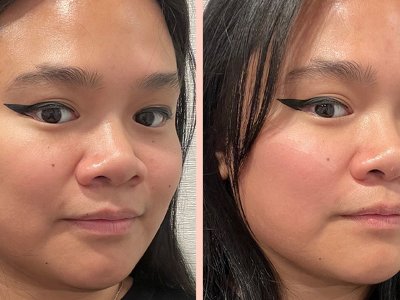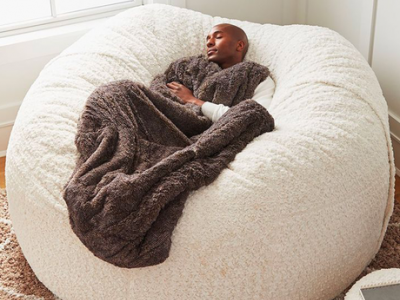Is Emface a Needle-Free Alternative to Botox and Filler? I Tried It

Twice a year, I get jabbed with neuromodulators and fillers to smooth my forehead and lift my cheeks. And every time I do, I not-so-silently panic as the extra-fine needles poke my face. My injector knows me as the one who "hums" during treatment. But newish-to-market Emface is being lauded as the facial treatment for everyone who's squeamish around needles because it is free of sharp points and requires no downtime.
It's hard to ignore the word-of-mouth testimonials, with many enthusiastic Emface fans taking to social media to hail it as an alternative to injectables — the hashtag "emface" has over 2.8 million views on TikTok — while others are proclaim it to be a nonsurgical facelift, offering patients the appealing possibility of a knife-free lift for their brows.
With dreams of a more contoured appearance in my mind and my trusty stress ball in hand, I knew I had to try it — and I was not disappointed. Here's a complete rundown of my experience getting Emface, including before-and-after comparisons that show results so visible, even my skeptical self can't deny them.
Emface is a device from BTL Aesthetics, the group that created the popular body-contouring devices Emsculpt and Emsculpt Neo. Emface works to smooth and lift by pushing two types of energy, radiofrequency and high-intensity facial electromagnetic stimulation (HIFES), through applicator pads that are strategically placed on the face.
Basically, radiofrequency energy (a mouthful, for sure) is thermal energy that may help stimulate collagen production through micro-injury. HIFES extends deeper and, in this case, targets the forehead muscle (the frontalis) and cheek muscles (zygomaticus major, minor, and risorius) to help lift and tighten them, says Yael Halaas, MD, FACS, a board-certified facial plastic surgeon and the first practitioner to administer the Emface treatment to patients. Clinical trials sponsored by BTL found that Emface helped reduce wrinkles by 37 percent and visibly lifted the face by 23 percent.
But some doctors are skeptical of the technology, such as board-certified dermatologist Sheila Farhang, MD, who does not carry Emface in her practice. "While I love the use of radiofrequency and am an advocate for the stimulation of collagen as an adjunct to injectables and good skin care, electromagnetic stimulation [like that of HIFES] is not something I think is as useful for the aging face," she says. "Of note, the clinical trials detail an increase in muscle tone and lift, which is different from [increasing] volume. Tone and lift are great if that is the goal, but for those who need their volume loss replaced, [they] may need to pair the treatment with something that adds volume, such as filler."
Dr. Farhang explains further that while muscle atrophy, which can manifest as volume loss, is part of the aging process, it isn't the aspect of aging that most patients ask her to address. "I see signs of muscle thinning in thin patients over the age of 55," she says. "And while studies have shown [Emface] adding volume, I'm unsure if the percentage changes found in clinical trials would be enough to actually create the look of more defined cheekbones through volume, as filler would."
Still, with everyone talking about the procedure, I had my heart set on getting an appointment and trying it.
Before we get into whether Emface worth the time and money, let's talk about the price tag — naturally, this is one of the biggest factors for prospective patients. Costs vary by practitioner, but four 20-minute sessions — a full treatment course — can cost between $4,500 to $6,000. You have the option of buying single sessions or four as a package, with most clients opting for the latter.
I twice yearly get Botox in my forehead to maintain smoothness and a touch of Juvéderm Voluma in my cheeks to add definition to my heart-shaped face. Again, though, needles scare me and, if possible, I was ready to drop them in favor of this procedure.
For optimal results, doctors recommend getting the treatment once a week for a month, but I got the treatment only three times, approximately six weeks apart. Life happens, and while it's just a 30-minute appointment, my schedule kept me from making more visits to the dermatologist's office. Practitioners say that Emface's effects, which can last up to a year, compound on each other with every appointment. (In other words, not all is lost if you miss a week.)
In anticipation of the large pad — or grounding pad, through which radiofrequency energy exits the body — placed on my back and smaller pads placed on my cheeks and forehead during the treatment, I wore an easy-to-lift shirt and skipped skin care and complexion makeup.
By Aliza Kelly
By Marci Robin
By Emily Newhouse
After placing the grounding pad on my back, my practitioner wiped my cheeks and forehead with an alcohol swab to ensure the absence of dirt and oils. This burned like hell, as my skin was extremely dehydrated, but that was the most painful part of the whole experience. My practitioner applied the pads to my face and switched on the machine.
Emface doesn't hurt, but it does take getting used to. The heat of the pads was bearable, but combined with the energy stimulating my facial muscles, the sensation was intense. As the HIFES pulsed through the pads, I felt my muscles being pulled, causing me to blink and scrunch up my face. Specifically, the pad along my forehead sent energy across my scalp, creating an odd — but ultimately relaxing – feeling similar to the one you get with those whisk-looking, wire head/scalp massaging tools. My practitioner started me at a low setting, but slowly increased it as I got used to the feeling. Halfway through the treatment, the device was at its highest setting.
As you can see from the photos I took after sessions one and two, my face looked flushed right after the treatment, from the pads' heat. My face also looked slightly more sculpted, with the lifted look of my cheeks being especially visible.
By Aliza Kelly
By Marci Robin
By Emily Newhouse
A week before my third session, I decided to re-up on Voluma along my cheekbones (given my twice yearly schedule, I was due). The images below show my results after fresh injectables plus Emface. As you can see, Emface enhanced the effects of my filler, slightly lifting my cheeks. It also made my skin look firmer and pulled my jawline upward (which looks more subtle in person than in photos).
Emface has minimal risks, says Paul Jarrod Frank, MD, a board-certified dermatologist in New York City: "There's always the risk of a burn and there are certain limitations — like [you can't get it if you have] certain types of metal in your body because there is a current that runs through your body to stimulate the muscle — but it is a very safe, noninvasive technology."
If you're hoping Emface will replace filler and Botox, you'll be disappointed; it doesn't work that way. "It doesn't mimic the effects of Botox or fillers," says Dr. Frank. The device, however, complements the use of injectables. "We like to call Emface an injectable-sparing technology, meaning that it strengthens muscles and tightens skin to lift." He goes on to say that it can improve the results of Botox and fillers and help prolong the period between appointments.
Like just about any procedure, the question of whether or not Emface is worth its steep cost depends on who you ask and how happy a person is with results depends on their expectations for treatment. If you're under 55 years old, Dr. Farhang says, "results on the face may be very subtle." Those over 55 are more likely to experience muscle thinning and see more changes.
By Aliza Kelly
By Marci Robin
By Emily Newhouse
Dr. Frank echoes this point, adding that other factors such as genetics, lifestyle, and how saggy skin is at the time of treatment can impact success with the treatment. Emface may be enough to tighten mild sagging on areas like the jawline, but moderate to severe laxity most likely won't be adequately lifted.
It helps to follow treatment protocol, and getting Emface once a week for four weeks will produce the best (and most visible) results. Again, I didn't do four weeks, but I was still happy with Emface's smoothing and lifting effects. It's worth having an in-depth conversation with your doctor to see if Emface will yield the results you're after.
Read more about injectables:
Watch a dermatologist's entire routine:
Don't forget to follow Allure on Instagram and Twitter.
- Last
News by day
26 of April 2024







